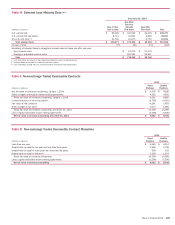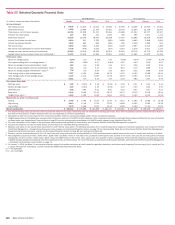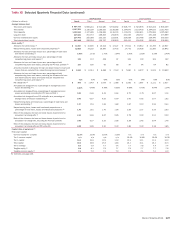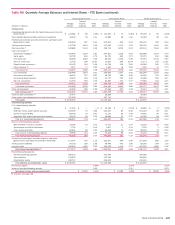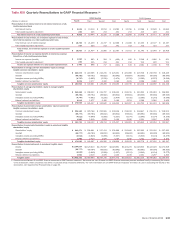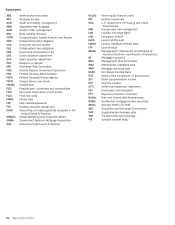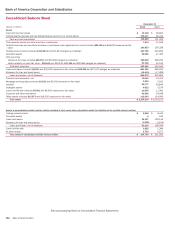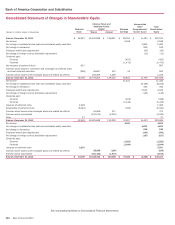Bank of America 2014 Annual Report Download - page 136
Download and view the complete annual report
Please find page 136 of the 2014 Bank of America annual report below. You can navigate through the pages in the report by either clicking on the pages listed below, or by using the keyword search tool below to find specific information within the annual report.134 Bank of America 2014
Glossary
Alt-A Mortgage – A type of U.S. mortgage that, for various reasons,
is considered riskier than A-paper, or “prime,” and less risky than
“subprime,” the riskiest category. Alt-A interest rates, which are
determined by credit risk, therefore tend to be between those of
prime and subprime home loans. Typically, Alt-A mortgages are
characterized by borrowers with less than full documentation, lower
credit scores and higher LTVs.
Assets in Custody – Consist largely of custodial and non-
discretionary trust assets excluding brokerage assets
administered for clients. Trust assets encompass a broad range
of asset types including real estate, private company ownership
interest, personal property and investments.
Assets Under Management (AUM) – The total market value of
assets under the investment advisory and discretion of GWIM
which generate asset management fees based on a percentage
of the assets’ market values. AUM reflects assets that are
generally managed for institutional, high net worth and retail
clients, and are distributed through various investment products
including mutual funds, other commingled vehicles and separate
accounts. AUM is classified in two categories, Liquidity AUM and
Long-term AUM. Liquidity AUM are assets under advisory and
discretion of GWIM in which the investment strategy seeks to
maximize income while maintaining liquidity and capital
preservation. The duration of these strategies is primarily less
than one year. Long-term AUM are assets under advisory and
discretion of GWIM in which the duration of investment strategy
is longer than one year.
Carrying Value (with respect to loans) – The amount at which a loan
is recorded on the balance sheet. For loans recorded at amortized
cost, carrying value is the unpaid principal balance net of
unamortized deferred loan origination fees and costs, and
unamortized purchase premium or discount. For loans that are or
have been on nonaccrual status, the carrying value is also reduced
by any net charge-offs that have been recorded and the amount
of interest payments applied as a reduction of principal under the
cost recovery method. For PCI loans, the carrying value equals fair
value upon acquisition adjusted for subsequent cash collections
and yield accreted to date. For credit card loans, the carrying value
also includes interest that has been billed to the customer. For
loans classified as held-for-sale, carrying value is the lower of
carrying value as described in the sentences above, or fair value.
For loans for which we have elected the fair value option, the
carrying value is fair value.
Client Brokerage Assets – Include client assets which are held in
brokerage accounts. This includes non-discretionary brokerage
and fee-based assets which generate brokerage income and asset
management fee revenue.
Committed Credit Exposure – Includes any funded portion of a
facility plus the unfunded portion of a facility on which the lender
is legally bound to advance funds during a specified period under
prescribed conditions.
Credit Derivatives – Contractual agreements that provide
protection against a credit event on one or more referenced
obligations. The nature of a credit event is established by the
protection purchaser and protection seller at the inception of the
transaction, and such events generally include bankruptcy or
insolvency of the referenced credit entity, failure to meet payment
obligations when due, as well as acceleration of indebtedness and
payment repudiation or moratorium. The purchaser of the credit
derivative pays a periodic fee in return for a payment by the
protection seller upon the occurrence, if any, of such a credit event.
A credit default swap is a type of a credit derivative.
Credit Valuation Adjustment (CVA) – A portfolio adjustment required
to properly reflect the counterparty credit risk exposure as part of
the fair value of derivative instruments.
Debit Valuation Adjustment (DVA) – A portfolio adjustment required
to properly reflect the Corporation’s own credit risk exposure as
part of the fair value of derivative instruments and/or structured
liabilities.
Funding Valuation Adjustment (FVA) – A portfolio adjustment
required to include funding costs on uncollateralized derivatives
and derivatives where the Corporation is not permitted to use the
collateral it receives.
Interest Rate Lock Commitment (IRLC) – Commitment with a loan
applicant in which the loan terms, including interest rate and price,
are guaranteed for a designated period of time subject to credit
approval.
Letter of Credit – A document issued on behalf of a customer to
a third party promising to pay the third party upon presentation of
specified documents. A letter of credit effectively substitutes the
issuer’s credit for that of the customer.
Loan-to-value (LTV) – A commonly used credit quality metric that
is reported in terms of ending and average LTV. Ending LTV is
calculated as the outstanding carrying value of the loan at the end
of the period divided by the estimated value of the property
securing the loan. An additional metric related to LTV is combined
loan-to-value (CLTV) which is similar to the LTV metric, yet combines
the outstanding balance on the residential mortgage loan and the
outstanding carrying value on the home equity loan or available
line of credit, both of which are secured by the same property,
divided by the estimated value of the property. A LTV of 100 percent
reflects a loan that is currently secured by a property valued at an
amount exactly equal to the carrying value or available line of the
loan. Estimated property values are generally determined through
the use of automated valuation models (AVMs) or the CoreLogic
Case-Shiller Index. An AVM is a tool that estimates the value of a
property by reference to large volumes of market data including
sales of comparable properties and price trends specific to the
MSA in which the property being valued is located. CoreLogic Case-
Shiller is a widely used index based on data from repeat sales of
single family homes. CoreLogic Case-Shiller indexed-based values
are reported on a three-month or one-quarter lag.
Margin Receivable – An extension of credit secured by eligible
securities in certain brokerage accounts.



